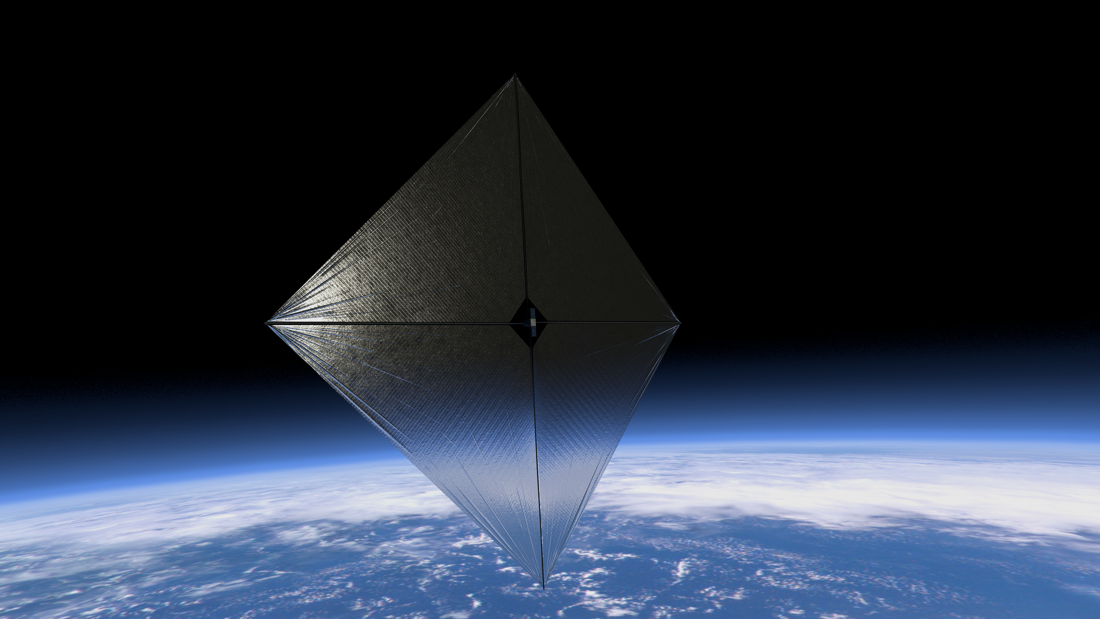Thankfully for us, the spacecraft that deployed the sail contains four cameras that can capture a panoramic view of both the reflective sail and the accompanying composite booms. The first of the high-resolution imagery is expected to be accessible on Wednesday, Sept. 4.
I can’t wait.
Though photons don’t have mass, they can force momentum when they hit an object — that’s what a solar sail takes advantage of.
Sounds like a bug.
It’s a feature.
Either way, NASA is already exploiting it. I guess, next they’ll find a way to glitch through the very fabric of the universe to teleport to a distant galaxy without moving at all or even using any energy.
Must be a problem with floating point precision.
Infinite energy glitch
Yeah, why do masless particles have momentum? And please not because law X says so.
In short, even though photons have no mass, they still have momentum proportional to their energy, given by the formula p=E/c. Because photons have no mass, all of the momentum of a photon actually comes from its energy and frequency as described by the Planck-Einstein relation E=hf.
From here: https://profoundphysics.com/if-photons-have-no-mass-how-can-they-have-momentum/
Essentially, momentum is a function of energy, not mass. It’s just that massive objects have way more momentum than massless ones.
Essentially, momentum is a function of energy, not mass.
Thanks! That’s the critical piece of information.
Because they have mass. They don’t have “mass at rest”, but they are never at rest anyway.
Do you remember that famous
E = mc^2equation? Everything that has energy has mass.But how do you apply this with Lorentz’ transformation (i.e. relativistic factors)? You cannot approach the speed of light without considering relativism. It is known that
p = gamma * m * vwhere p is momentum, gamma is the gamma factor given bysqrt(1/(1 - (v^2/c^2))), m is mass and v is velocity. If you study the gamma factor, you’ll realize that it approaches infinite as v approaches c, the speed of light. Since we are actually dealing with light here, wherev = cwe are breaking the equation. Momentum cannot be defined for any mass which moves at the speed of light. It’s asymptotic at that speed.Also note that the same goes for
E = mc^2. At relativistic speeds, also this equation needs to consider the gamma factor. So those classical equations break down for light.The answer is that photons don’t have mass, but they have energy. There is a good explanation a bit further up in this thread on how this is possible.
The one that you multiply with gamma is the rest mass, not the total mass.
To be short,
p = m_0 * γ * v, wherem_0is the rest mass. Put that in your equation and look what happens.
So photons only have no mass if they don’t move? Do they even exist if they don’t move?
Do they even exist if they don’t move?
No. Or, at least not from our point of view.
They only exist moving at the speed at light. All particles with no rest mass only exist moving at the speed of light.
So photons do have mass?
only as long as they exist
Else they don’t. We are talking quantum here.
So, since you cannot delete mass, do they just endlessly bounce / reflect off when hitting something, like the sail?
They can also be created or absorbed into something else. The mass of whatever absorbs them increases, and the mass of whatever is emitting them decreases when they do that.
The mass of everything is changing all the time. The thing that is constant is the rest mass.
The object doesn’t absorb their mass, but rather their energy (which admittedly can be equated to a mass via a factor of c^2, but that’s not actually what’s happening). The change in momentum that results from a photon hitting you isn’t caused by a change in m, it comes from a change in v. If mass were the quantity being transferred, solar sails wouldn’t work to move anything; they would just sit there and get more massive as photons hit them.
That’s how kamehamehas work, right?
Energy is mass
Witchcraft.
deleted by creator
Radiation pressure does not have anything to do with mass-energy equivalence. 1), the energy for this process does not come from the conversion of electric energy into mass, and 2) having a momentum is not a property tied to massive particles. All electromagnetic waves carry momentum according to Maxwell’s theory of electromagnetism, and its transfer is fully explained by his equations and results from the interaction of the EM wave with matter, i.e., absorption and reflection. Each such interaction will transfer momentum to the massive object. This is classical physics, you don’t need any Einstein relativity to explain electromagnetic phenomena because his theories only become relevant for very massive bodies and their movement, and nuclear reactions.
ok, that’s quite far over my head but I will take your word for it
Ok, a side note on etiquette here.
When I saw this reply it had a point score of 0, which means somebody downvoted the post.
When a user is freely admitting a lack of expertise, and defers to another user who seems to know better, I would say it’s extremely rude to downvote that reply.
This is an example of a user going out of their way to humbly rescind their previous statements when it appears they were mistaken (this is admirable and not a thing that usually happens on the Internet). They didn’t do it for their own benefit, but for the benefit of the community, to not leave misleading or incorrect information in the comments.
So to sum up, downvoting a selfless act is pretty shitty and not good for the community.
in fairness, I was terse in my original response and probably came off as insincere. Thank you though. I try not to leave up misinformed statements when it turns out to be a learning moment.
This NASA video is pretty amazing. I was wondering how they did the booms and they are soft carbon fiber tubes rolled up on spools. I was imagining that you could simply spin the sail and use centrifugal force to expand it.
Maybe someone can answer me this: I’ve always wondered if a solar sail can only generate momentum away from the sun or if it can be angled to create momentum in other direction. Since the light is reflected and not absorbed, angling it e.g. 45° you change the “momentum” of the photons. That should also change the momentum impacted on the solar sail and spacecraft. Right?
Maybe someone can answer me this: I’ve always wondered if a solar sail can only generate momentum away from the sun or if it can be angled to create momentum in other direction.
Yeah, 100%. You can totally steer and control your orientation with a solar sail. This is one of the rare actually intuitive things when it comes to spaceflight. (with physics in space It seems like nothing actually works the way you’d expect it to, but this basically does)
We actually have some experience controlling orientation with “solar sails” too. I remember one example of a spacecraft which long after finishing its official mission was left to tumble out of control. Years later, some engineers were able to regain control, use the last of its propellant to counter its tumble and then keep it oriented correctly using only its solar panels as sails, light pressure was carefully controlled to keep the spacecraft oriented.
I could be mistaken, but I believe NASA used the same technique with light pressure to keep Kepler oriented properly as its reaction wheels each failed in sequence.
Ah thank you, never seen that mentioned. That makes it even more awesome for solar system exploration! The article mentioned expanding to much larger designs too.
PS: Now I wonder if assembling these solar sails with lightweight girders in orbit on a space station would be worth it. The spooling mechanism is awesome but if you could just send it up dis-assembled and assemble it in space they could probably be more efficient.
Well… I’m afraid I’m not sure if they’ll be effective for the ISS. The ISS sits in low orbit (a relatively high part of Leo, but none the less), so it hits some extremely thin atmosphere, which has a noticeable drag over time. For that reason the ISS has to boost its orbit a little every few months. My fear is that a solar sail large enough to have an effect on the ISS is probably large enough to add a whole lot of atmospheric drag, even from just the trace particles it encounters.
Oh right, yeah. Hopefully we’ll see a higher orbit space station that can do manufacturing like this.
Yeah, we may well end up seeing a lot more use of solar light pressure to orient spacecraft over the coming years, especially deep space probes and higher orbit satellites. Telecom satellites need a lot of power for their transmitters, so they generally have quite large solar arrays, I wouldn’t be surprised to see some of those using this method for station keeping. (Though these days they’re already using very efficient ion thrusters for station keeping, so they may not really need to use this method)
But while solar sail propulsion takes a lot of very specific design requirements, using solar pressure just for maintaining orientation doesn’t actually require any fancy hardware (if you already have solar panels), it’s all an entirely software solution. Which means it’s always a viable backup plan when hardware failures occur.
Yeah exploring for asteroid mining and the asteroid belt being 2-3 AU from the sun, you have 4 to 9 times less solar pressure. But you could still accelerate closer to the sun and then swing out. I imagine tiny cube sats with cheap solar sails could do much of the work there. Anyway, exciting times!
Well that’s a really interesting application though… 9 times less thrust may not actually be a very big deal. A solar sail probe would likely be a lot lighter than a fueled equivalent, so that means you have the payload mass to send more probes on the same launch. And asteroids don’t have meaningful amounts of gravity, so you can take as long as you want to get from one to another (you don’t need much thrust to overcome their gravity well). So yeah, I think more than likely you could make up for a lack of speed with sheer quantity.
Haven’t heard about the NASA design yet, but JAXA’s 2010 IKAROS used "Eighty blocks of LCD panels are embedded in the sail, whose reflectance can be adjusted for attitude contro ".
That’s such a badass design, I love it.
A variable thrust and thrust vectoring propulsion system with no moving parts. I doubt that’s ever been done before…
Oh wow interesting. So using LCD is more efficient in weight than using motors to tilt the sails? Or maybe the advantage is not having to counter any sail movement with gyroscopes… which cost energy too.
Or maybe the advantage is not having to counter any sail movement with gyroscopes… which cost energy too.
I think you nailed it right there.
I wonder how long it will take to get to Cardassia
I’d be content with Proxima Centauri. But that’ll still take a little while.
Indeed. In Deep Space 9, they built one and tried to sail it from Bajor. Got caught in a field of tachyons and ended up at Cardassia. Would essentially be like us making it to Proxima Centauri though.
Oh yeah, I remember that one. I feel like it bothered me, but I could swear I knew nothing about solar sails back then.
Yo ho yo ho a pirates life for me!
There is no rum in space
But why is the rum gone?!?
I hope it can be sent somewhere neat once they are done testing. But I assume it’s not configured for long range communication.
It would be cool if it could be sent, slowly, to a “nearby” body.
Iirc, solar sail designs like this can actually go stupid fast when properly propelled by something like a laser array.
What’s fun about these is that the mass of the actual vehicle can be much smaller if it doesn’t need to carry rocketry and fuel on board. So even though they’ll never compete with rockets for power (energy used over a specific length of time), starting at a lighter weight and never running out of fuel means that these systems could theoretically exceed the top speeds (relative to the earth) of our fastest rockets, given enough time.
How do they slow down or stop; is it by reversing the sail?
Won’t the sail approach the speed of light if it stays on course in line with the sun for an exceptionally long time?
No, because the solar wind drops off around 100 AU, and the power of the solar wind is going to reduce the farther out you are. These kinds of craft would get much more acceleration from a laser array that can put much more concentrated energy into the sail. But just like the solar wind, it will lose power the farther away from the array it is, along with any kind of intermediary debris attenuating the beam or unfavorable angles between the array and the craft.
So you can get these to an appreciable fraction of the speed of light, but I don’t think we’d be able to get anywhere close to c with this kind of a setup.
Edit: I was wrong about the solar wind above, it’s only like .5% as powerful as the photons emitted by the sun, and that energy drops off at only 1.5 AU, so they’ll get much less energy than I thought without an external power source like a laser array.
I suppose it can’t build up enough speed by going in direct line out of the solar system as the falloff would mean there’s not enough “runway” so to speak. But I wonder if you could circle the sun and “tack” like a ship does sailing into the wind and build up more momentum that way?
You could have an eccentric orbit that swings far out into the solar system and then when it approaches the sun again accelerates to reach the escape velocity of the sun. But that would take years.
And I think still only be rather slow once it escapes the solar system since the escape velocity would be almost used up.
There is the concept of a nuclear photonic rocket - Wikipedia which I think of as a light sail and a white hot glowing lump of nuclear fuel on a string.
Doesn’t “solar wind” refer to the physical particles emitted from the sun? Like hydrogen, helium, etc ejected from the sun’s outer layers?
My understanding is that the solar sail is propelled mostly by the photons themselves, not the atomic particles that may also be reaching it.
Of course this probably doesn’t change your argument at all, since the intensity of light drops off precipitously as you fly further and further from the sun.
You’re correct, the solar wind is like .5% the energy of the emitted photons and really begins to diminish after only 1.5AU, so they’re even less effective in system without a laser array than I half remembered.
I believe this is one of those things that benefits from scale. Theoretically, the larger you make the sail, the better the thrust to mass ratio you can achieve (even before calculating a better payload mass to sail mass ratio). With improved materials, we can make stronger and lighter sails and support structures, and this will in turn result in higher velocities by the time the vehicle has left the effective range of the sun. I think speeds truly approaching c are unlikely, but they can still achieve “really freaking fast”.
But then new advanced materials could also change that, we’re developing metamaterials with some fascinating properties, carbon nanotubes are just the tip of the iceberg. Who’s to say that we couldn’t some day achieve those speeds.
Just to zoom by the target in 100000 years so quickly no pictures or data can be captured.
There’s a paper from 1984 that worked out the math for a two-sail system that could get a spacecraft to Alpha Centauri, and slow down and end up in that gravity well, with a 41-year mission time. It would do so by discarding a reflector that points backward at the actual payload with its own sail. The paper also proposes a mechanism for a round trip mission, too, using 3 sails.
That’s actually not that big of a deal!
Since these craft would be small, they wouldn’t have the power to transmit back to Earth anyway. So with something like this, you would actually want a string of these kind of crafts that you would propel along the same vector so that they could send the data back using each following craft as the next point in the network back to Earth. So each one can take additional pictures to get a resolvable image at the end!
Now, getting them on the same vector is the hard part, since we’re constantly moving through space and won’t have the same launch conditions on subsequent launches, but this is all theoretical at this point anyway.
The scientist Robert L. Forward discussed possible ways to handle this in his novel Rocheworld. The fiction part wasn’t about the light sail, more the general AI, life extension tech, and the aliens.
Ramiel?
So hot right now!
First photo looks rather unspectacular: https://www.space.com/nasa-solar-sail-space-photo
NASA also has a “spot the diamond in the sky” challenge haha: https://www.space.com/nasa-solar-sail-space-photo
Here’s a picture of it while it’s still in the shop. https://inspenet.com/en/noticias/nasa-tests-solar-sail-in-solar-in-orbit/











